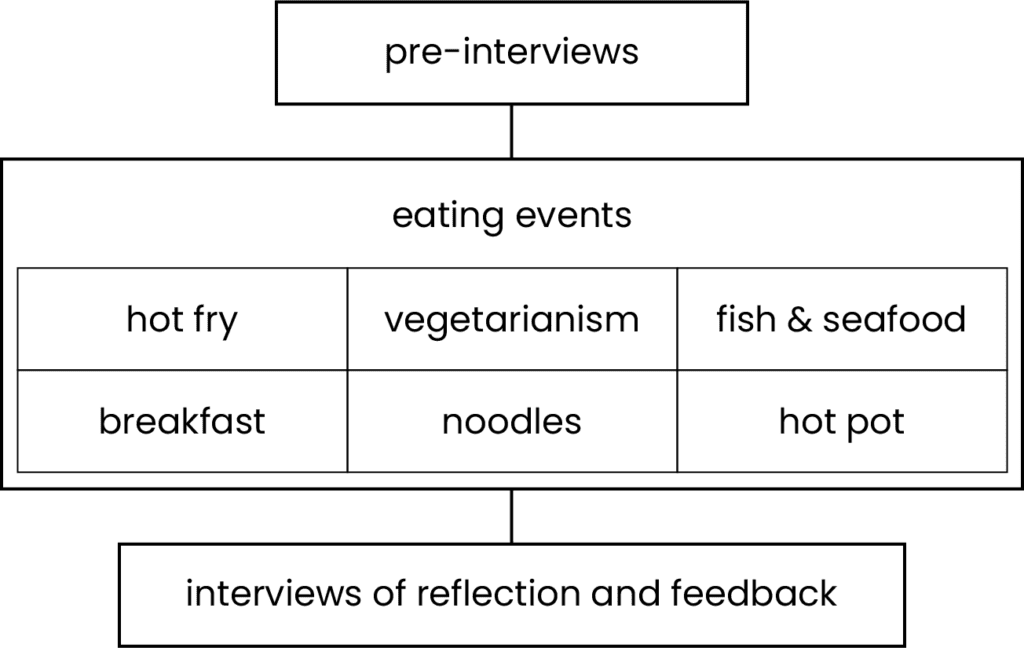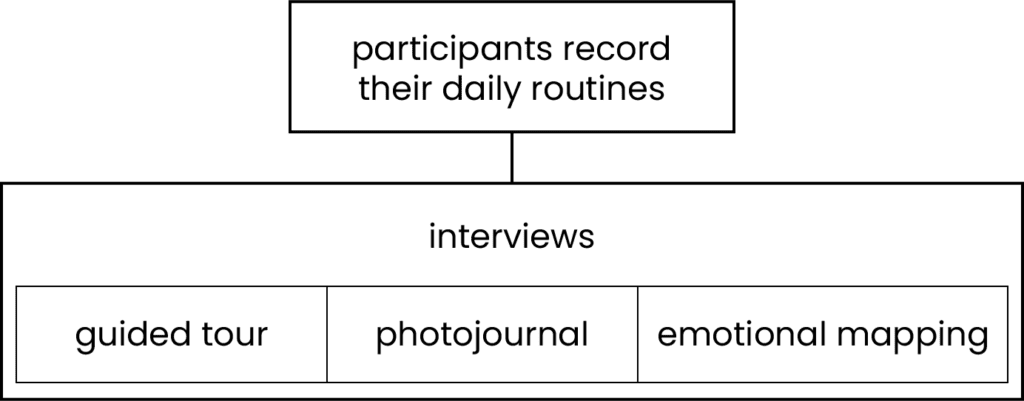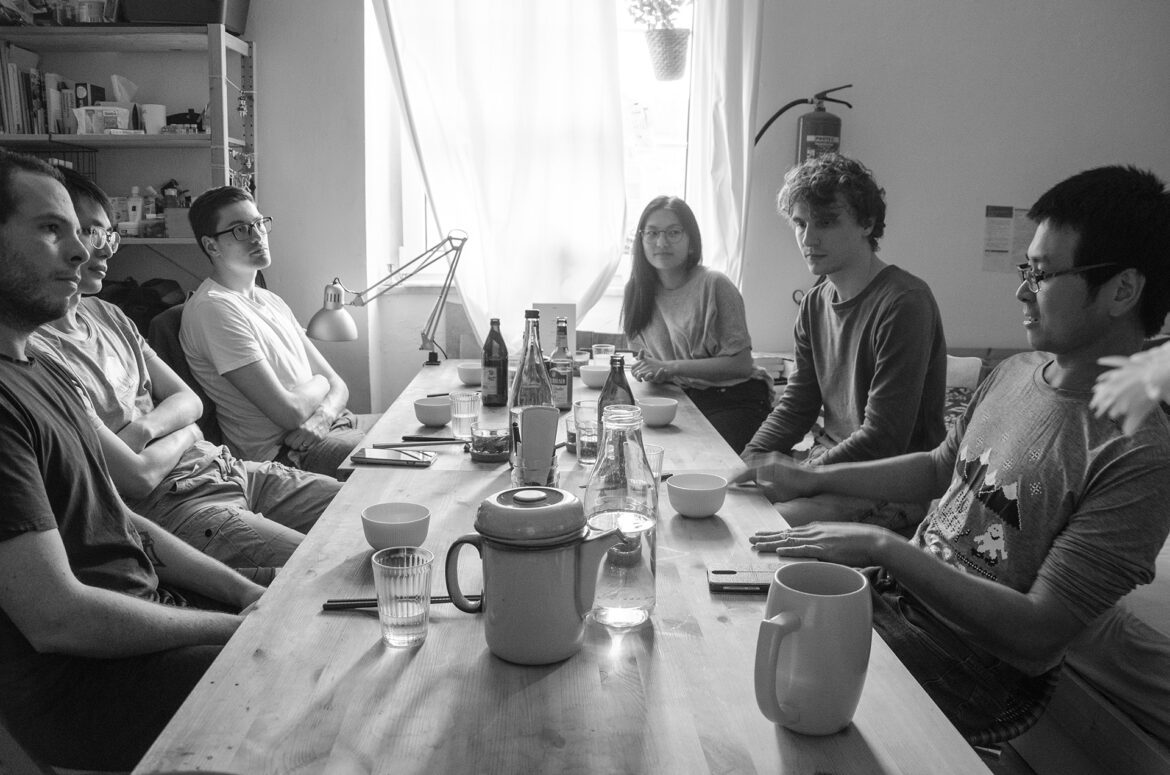
“
… the cooking of a society is a language in which it unconsciously translates its structure – or else resigns itself, still unconsciously, to revealing its contradictions.
Claude Lévi-Strauss. 2012. The Culinary Triangle.
Research on cross-cultural communication through eating experience design
A Food Journey from Taiwan to Germany is an eating design project elaborated from Yen’s master thesis Cross-Cultural Communication through Eating Experience Design.
This research sought to learn how food transmitted cultural messages through eating experience between the Taiwanese and the German groups. The result provides a design solution for effective cross-cultural communication which catalyses empathy and understanding between 2 ethnicities.

The research focused on two ethnicities (Germans and Taiwanese) and was developed into two phases: Taiwan to Germans and Germany to Taiwanese. At the first phase, Germans were the receiver in the communication process decoding the cultural messages of an ethnic eating environment sent by Taiwanese. A series of questions and eating scenarios in Taiwan were designed to lead the experience.

At the second phase, qualitative interviews were conducted with three Taiwanese who had stayed in Germany for different lengths of time. The experience of Taiwanese and Germans intersected in Germany, forming an overlapping zone while providing room for understanding. The interviews aimed to acquire information about the integrating process of the Taiwanese people in Germany and the role of food for them.
3 courses with the implication of the phases foreigners adapt to a new culture layout the journey of Taiwanese in Germany.
Eating Settings
Both ethnic groups joined the conversation on the dining table. The banquet layout the journey of Taiwanese to Germany through 3 courses: Initial Encounter, from Unfamiliar to Familiar, and Feeling at Home, which told the stories of their arrival, the primary contact in a new cultural context, the measuring of differences and commonness, the adaptation, and the retrieve of home feel in an alien environment.
For Germans, the courses led the learning process from how to eat, what to eat, to why to eat. Each dish and course provided an overlapping field of German and Taiwanese experience as a channel of communication, either on the ingredients, tastes, styles or the associations with memories. Between courses, questions were thrown to the participants to discuss their impressions and stereotypes of their counterparts’ ethnicity. Through the known to the unknown, eaters perceived in others’ stands and further to empathise and understand their counterparts.
Starter: Initial Encounter
One spare bowl and one bowl with a dumpling were served. Spices in different shapes and volumes were placed in the middle of the tables. Eaters followed the instructions of chopsticks printed on the placemat papers to assemble their dumplings. It implied the initial encounter of a new cultural environment. Every rule, idea, event and experience was dismantled and needed to be recaptured.
Main Course: From Unfamiliar to Familiar
The main course reconstructed the typical Taiwanese eating by serving multiple dishes for sharing. Every dish incorporated elements inspired by the food familiar to Germans into Taiwan traditional cookery. It provided links for both sides to learn about the cultural contexts from the ingredients they knew.
The last dish Runbing introduced the regional and individual differences by its composition based on local flavours and personal tastes. Participants were asked to wrap runbings and passed to their neighbours. The seat arrangement ensured everyone would obtain the plate from an ethnic counterpart. Eaters described the tastes of runbings they received, while the preparers explained their recipes. Through exchanging and tasting, eaters absorbed their counterparts’ memories and interpretations of food.
Dessert: Feeling at Home
Every participant brought one dessert related to the idea of home. Definition of home was open to interpretation. While sharing the dessert, participants explained the correlations of the dessert to their feelings of home. Through story-telling and the tastes of home, eaters discovered their similarity regardless of the places they came from.

Food is a mean of consolation and a retrieve of home memory.
Observation and Review
The general atmosphere during the banquet was unwinding. Without instructions, the guests swiftly familiarised with each other by themselves. Eaters’ backgrounds provided scopes for both sides to receive insights into another cultural context. Talking subjects opened up around and upon the food served. Food and eating tools led the taste experience, while the composition of them drew out topics of the culture presented. Discussions about conventions, history, politics, economic influences and mindsets were stirred up.
The seat arrangement of one Taiwanese and one German played a crucial role in this eating design. Eaters had an overview to observe and lent hands when their neighbours required guidance. Due to the familiarity with the eating formats, Taiwanese jumped into an active role assisting and explaining to others. It also provided chances of interaction.
All participants mentioned that food had driven them to attend this experiment. The fruitful results regarding broadening visions for some were unexpected. From the banquet and the previous research, Yen discovered that the impact of extending or reshaping one’s worldview stressed on the German participants who had newly encountered Taiwanese cuisine. For the Taiwanese and Germans who had been in Taiwan, the food reinforced or awakened their memories. Moreover, the Taiwanese retrieved the connection to home. While German participants ate because of curiosity or merely hunger, Taiwanese gained consolation from home tastes during the dinner.
Sharing the living experience, history and culture from Taiwan is easier if you have some tasty local food as support aids. It was also very interesting to see the responses from the German guests who had ever tried ‘REAL’ Asian food first time in their lives, making me rethink about the food culture we have in Taiwan.
Yu Chun Chen-Kühnert
I learned some Taiwan images from Germans, even though they might implant the general Asia images on Taiwan.
Chih Hung Lin
The food is just great which brought us more memory than identity. In an eating event, we are inclined to see the common things among us rather than differences.
Chia En Lin
My most important takeaway is how easy it becomes to have conversations and a good time with strangers if food is involved. It gives you a common basis for discussion, whether it is how hungry you are, what it tastes like, or where it comes from.
Thomas Mühlbau
I found the conversations with the other participants inspiring because there were some new topics and perspectives opened up. Not only to learn about Taiwanese history and cultural matters but also to look at your own history and politics from a different perspective while explaining it to a non-german.
Benjamin Hahn
Every person brought some memorable ingredients for this special dinner. The stories behind made the most sense and sometimes have been of personal quality, which made the group become from familiar to intimate fast.
Moritz Kühlnert
